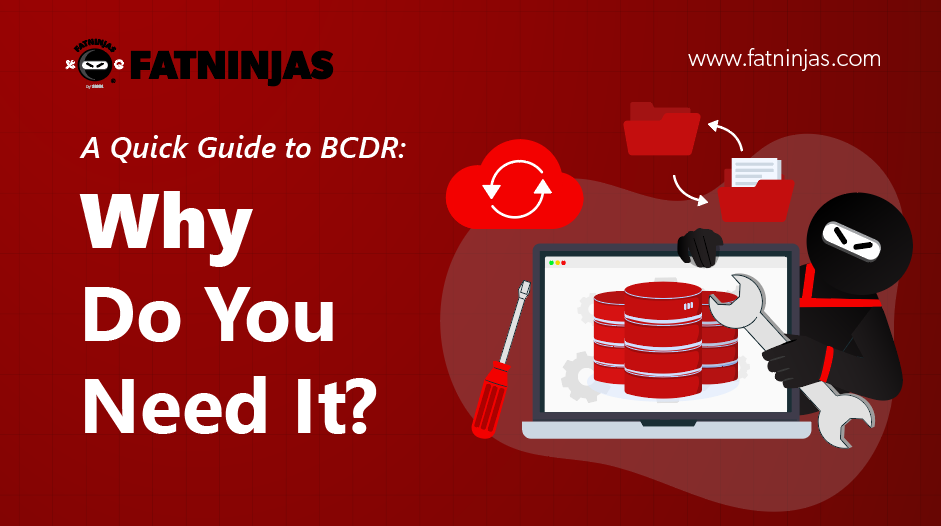A Quick Guide to BCDR: Why Do You Need It?
A Quick Guide to BCDR: Why Do You Need It?

In the dynamic landscape of technology, digital transformation has shaped the world of business as it is today. However, uncertainties and disruptions are bound to occur which are inevitable. The crucial question emerges: How confident are we in our business’s resilience to navigate through unexpected IT outages and downtime? This is where organizations can turn to Business Continuity and Disaster Recovery (BCDR), an essential asset that includes a comprehensive data recovery plan – for ensuring sustained business operations in the long run.
Understanding BCDR
BCDR is a set of approaches or strategies designed to assist businesses of all sizes in recovering from disasters. This comprehensive framework enables organizations to seamlessly resume operations after facing unexpected challenges, ensuring the continuation of business in the face of adversity.
Business Continuity vs Disaster Recovery
Business Continuity (BC) is a proactive strategy aimed at maintaining essential business functions during and after a disruptive event. The primary goal of BC is to ensure the ongoing availability of critical resources and personnel, minimizing the impact of disruptions. BC processes include risk assessment, business impact analysis (BIA), and the development of comprehensive business continuity plans.
Disaster Recovery (DR) is a subset of business continuity, focusing on the restoration of IT systems and data post-disruption. Unlike BC, DR’s scope is heavily focused on technology. Key components of DR include data backup and recovery, system restoration strategies, and regular testing and validation of the recovery plan. For instance, in the event of a server failure, a DR plan would involve procedures to restore data from backups, replace or repair hardware, and resume normal IT operations promptly.
While planning BCDR solutions, it’s imperative to consider the recovery time objective (RTO), the maximum time an organization can afford downtime, and the recovery point objective (RPO), the amount of data loss without significantly affecting the organization.
Why is BCDR important?
Business downtime and data loss can strike anytime without a warning, and a significant percentage of small businesses lack a data backup and recovery plan. This puts them at risk of potential data loss and, in extreme cases, business failure.
An effective BCDR plan acts as a crucial line of defense, protecting businesses, clients, and employees while providing peace of mind. Downtime can result from various causes such as human error, cyber-attacks, hardware failure, natural disasters, and power cuts. But the question remains: are we truly prepared for the worst-case scenario? Here’s why having a BCDR plan is essential:
- Cost-effectiveness
The idea of data loss happening during disruption is often overlooked, even though many major businesses could not afford the data recovery cost. When you invest in a comprehensive BCDR plan, you do not only mitigate the risks of losing your data but also save on recovery costs.
- Minimize downtime
Sometimes when you are experiencing natural disasters or hardware failure, it may take longer than you wish to resume operations. Downtime for businesses means losses, be it financial or productivity. Fortunately, with BCDR, it allows you to keep your business running with a backup of your most essential services, not compromising on downtime or with minimal disruption.
- Protect sensitive data
Ultimately, the purpose of having BCDR is to ensure that your data is always secured, especially during the event of disasters. BCDR ensures there’s security of personal and confidential information, giving you peace of mind.
- Build customer trust
BCDR keeps your business up and running as you face unexpected disruptions. When you can operate your business even during these dire moments, it verifies you as a reliable business partner and instills confidence in customers.
- Compliance adherence
Having a BCDR plan is necessary for compliance adherence because many organizations are required to demonstrate their commitment to data protection, security, and business continuity as part of regulatory requirements.
In need of a BCDR plan?
At FatNinjas, we recognize the pivotal role of BCDR in ensuring operational functions in case of unforeseen events. With our strong partnership with Datto, a global leading cybersecurity company, we leverage on Datto BCDR solutions to provide you a holistic approach to data protection, guaranteeing that your organization can stay afloat amidst the storms. With the user-friendly Datto 1-Click DR feature, it makes disaster recovery incredibly quick and easy with just a single click.
Reach out to our specialist today and learn more about our comprehensive BCDR solutions tailored to meet your organization’s needs. Don’t hesitate to schedule a demo with us here – https://www.fatninjas.com/contact-us/.
Let’s fortify your business against these potential disruptions and navigate the storms together!

In the dynamic landscape of technology, digital transformation has shaped the world of business as it is today. However, uncertainties and disruptions are bound to occur which are inevitable. The crucial question emerges: How confident are we in our business’s resilience to navigate through unexpected IT outages and downtime? This is where organizations can turn to Business Continuity and Disaster Recovery (BCDR), an essential asset that includes a comprehensive data recovery plan – for ensuring sustained business operations in the long run.
Understanding BCDR
BCDR is a set of approaches or strategies designed to assist businesses of all sizes in recovering from disasters. This comprehensive framework enables organizations to seamlessly resume operations after facing unexpected challenges, ensuring the continuation of business in the face of adversity.
Business Continuity vs Disaster Recovery
Business Continuity (BC) is a proactive strategy aimed at maintaining essential business functions during and after a disruptive event. The primary goal of BC is to ensure the ongoing availability of critical resources and personnel, minimizing the impact of disruptions. BC processes include risk assessment, business impact analysis (BIA), and the development of comprehensive business continuity plans.
Disaster Recovery (DR) is a subset of business continuity, focusing on the restoration of IT systems and data post-disruption. Unlike BC, DR’s scope is heavily focused on technology. Key components of DR include data backup and recovery, system restoration strategies, and regular testing and validation of the recovery plan. For instance, in the event of a server failure, a DR plan would involve procedures to restore data from backups, replace or repair hardware, and resume normal IT operations promptly.
While planning BCDR solutions, it’s imperative to consider the recovery time objective (RTO), the maximum time an organization can afford downtime, and the recovery point objective (RPO), the amount of data loss without significantly affecting the organization.
Why is BCDR important?
Business downtime and data loss can strike anytime without a warning, and a significant percentage of small businesses lack a data backup and recovery plan. This puts them at risk of potential data loss and, in extreme cases, business failure.
An effective BCDR plan acts as a crucial line of defense, protecting businesses, clients, and employees while providing peace of mind. Downtime can result from various causes such as human error, cyber-attacks, hardware failure, natural disasters, and power cuts. But the question remains: are we truly prepared for the worst-case scenario? Here’s why having a BCDR plan is essential:
- Cost-effectiveness
The idea of data loss happening during disruption is often overlooked, even though many major businesses could not afford the data recovery cost. When you invest in a comprehensive BCDR plan, you do not only mitigate the risks of losing your data but also save on recovery costs. - Minimize downtime
Sometimes when you are experiencing natural disasters or hardware failure, it may take longer than you wish to resume operations. Downtime for businesses means losses, be it financial or productivity. Fortunately, with BCDR, it allows you to keep your business running with a backup of your most essential services, not compromising on downtime or with minimal disruption. - Protect sensitive data
Ultimately, the purpose of having BCDR is to ensure that your data is always secured, especially during the event of disasters. BCDR ensures there’s security of personal and confidential information, giving you peace of mind. - Build customer trust
BCDR keeps your business up and running as you face unexpected disruptions. When you can operate your business even during these dire moments, it verifies you as a reliable business partner and instills confidence in customers.
Compliance adherence
Having a BCDR plan is necessary for compliance adherence because many organizations are required to demonstrate their commitment to data protection, security, and business continuity as part of regulatory requirements.
In need of a BCDR plan?
At FatNinjas, we recognize the pivotal role of BCDR in ensuring operational functions in case of unforeseen events. With our strong partnership with Datto, a global leading cybersecurity company, we leverage on Datto BCDR solutions to provide you a holistic approach to data protection, guaranteeing that your organization can stay afloat amidst the storms. With the user-friendly Datto 1-Click DR feature, it makes disaster recovery incredibly quick and easy with just a single click.
Reach out to our specialist today and learn more about our comprehensive BCDR solutions tailored to meet your organization’s needs. Don’t hesitate to schedule a demo with us here – https://www.fatninjas.com/contact-us/.
Let’s fortify your business against these potential disruptions and navigate the storms together!





